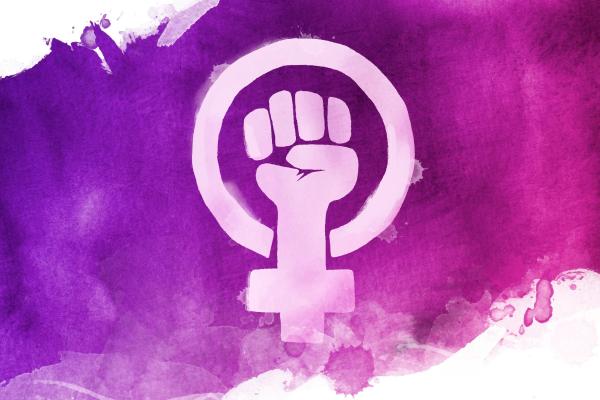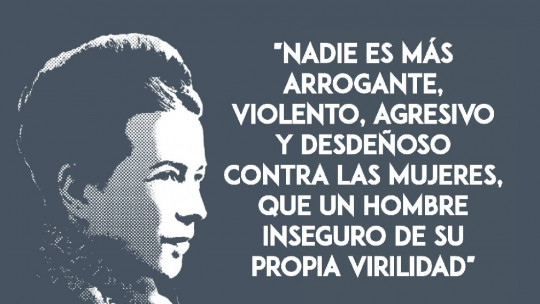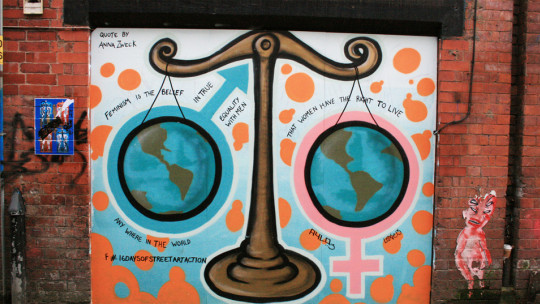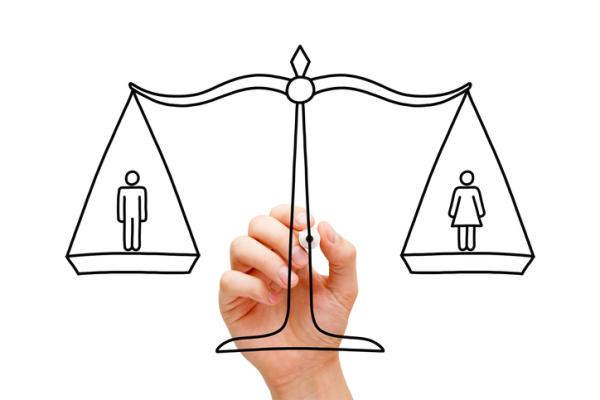Enlightened feminism, suffragism, sixties feminism and sorority and cyberfeminism were the four waves of feminism. Currently, at least formally and theoretically, both women and men maintain the same rights. However, if women have managed to acquire their current representation in society, it has been thanks to the struggle of many women during the last centuries in the feminist movement.
Throughout history, women have been oppressed by men in unequal conditions, being recognized only for being mothers, wives and housewives. She has been denied the right to vote, the opportunity to study, to be able to practice professions that were only “for men”, she has been denied the possibility of deciding if she wants to be a mother, entry to public spaces because she is a woman, among others. other inequalities. If you want to know how the movement has managed to abolish some inequalities between genders, don’t miss this article from Psicología-Online about the four waves of feminism and their demands
What is feminism
Throughout history, women have led the fight to achieve equal representation with men in society. The gender fight It has been involved in different stages, processes and changes, in which the women’s movement has managed to achieve great achievements thanks to its struggle. The trajectory of the changes achieved, thanks to the Feminist movement has been divided to date into stages, called the waves of feminism.
The stages of feminism have occurred as follows:
- First wave: It took place in the French Revolution, being called Enlightenment feminism.
- Second wave: Subsequently, from the mid-19th century until the end of World War II, the movement embarked on the second wave, liberal-suffrage feminism.
- Third wave: In the 1960s, the third wave of feminism appeared, sixties feminism or contemporary feminism.
- Fourth wave: Currently, we can see the beginning of the fourth wave of feminism, feminism after the eighties.
Thus, we can affirm that today there are four feminist waves.
history of feminism
He birth of the feminist movement It dates back to the 18th century, during the beginning of the French Revolution and the Enlightenment. The feminist movement arose from the need for women’s liberation, seeking a change in social relations, through the hierarchical elimination and inequalities between genders. It was then that the women came together as a collective to fight for freedom, civil rights, justice and equality rights pledged by and for men at that time, excluding women from them.
As a result of this first awareness of the oppression of women in our society, throughout history there have been great movements or stages of feminism, achieving great advances to this day. These stages, known as the waves of feminism compress the history of the movement with its achievements and difficulties, which feminism has had to overcome to this day.
In the following sections we will see the historical journey of the movement based on the four waves of feminism. If you want to know more about its history, we recommend reading this article about the History and currents of feminism.

First wave of feminism
The first of the four waves of feminism was born in the 18th century, against the beginning of the French Revolution and the Enlightenment The main objective of the French Revolution was the achievement of the principles of liberty, equality and fraternity. However, the freedoms, rights and legal and political equality so pursued by the revolution excluded women.
Thus, the first wave of feminism began due to the lack of representation of women in the principles that supported the revolution, directly related to men and exclusive for women. It was then that the women’s group began to fight for your equality rights and by the need to highlight the role of women in society, which had remained hidden until then.
The demands of the women’s collective that rose up in the first wave of feminism focused on women’s access to the following rights:
- To the education
- To the freedom
- To the equality
- To the political rights: expressing your right to vote.
However, the response they obtained to their demand in the Napoleonic Civil Code was the creation of discriminatory laws, such as ruling that the home was an exclusive area for women. It was established that women would be considered minors and specific crimes such as adultery or abortion were established. In addition to this, women continued to be excluded in the educational field.
Within the framework of the stages of the feminist movement, in the first wave it began to awareness of oppression of society on women, they wanted to stop being only mothers and wives.
Second wave of feminism
The second wave of feminism, known socially as suffragism took place between the mid-19th century until the 1950s, at the end of the Second World War.
Second wave of feminism in the United States
The second stage of the feminist movement began in the United States, where four women joined the fight for the country’s independence and the cause for the liberation of slaves. These two events gave rise to women beginning to deal with social and political issues. Given this, suffragism was born, which pursued two objectives: the right to vote for women and the right to education which remained related, since the movement defended that with the possibility of educational training it would be more difficult to deny them the right to vote.
The movement’s collective remained interclassist, since it was considered that every woman suffered from these inequalities, regardless of their social class. At that time, the passive revolution that had begun to take place changed its strategy to become an active movement, where women began to have a more activist role carrying out actions such as interrupting speeches or carrying out hunger strikes.
The strength of the movement began when the four women who had fought for independence and slaves in the United States traveled to England to attend an anti-slavery congress, to which they were denied entry because they were women. After several years of struggle in England, John Stuart Mill positioned himself as an ally of the movement, indicating that the solution to the women’s struggle was to eliminate discriminatory legislative positions, since once these restrictions were eliminated, women could leave the subordination and begin to become independent.
Second wave of feminism in Europe
It was not until the end of World War II that women in England did not obtain the right to vote, since During the war, women began to take men’s jobs that they had gone to war and, given this, society could not oppose their demands. Faced with this, in the 1930s the vast majority of developed countries had reconsidered and recognized women’s right to vote.
The struggle of feminism continued with the demand for free access to higher education, gender equality in all professions, as well as in salary and civil rights, the right to share parental authority over their children. They also claimed the injustice of the husband having to be the administrator of the marital property.
Even after the war, the media and governments focused on the objective of removing women from the jobs carried out during the war, returning them to the home, a maneuver called The mystique of femininity
Third wave of feminism
The third wave of feminism arrived in the Sixties decade, where faced with the mystique of femininity, women felt empty because of the role they should play in society, that of mother, wife and housewife. It was then that Betty Friedan created the National Organization for Women (NOW), becoming the most representative women’s organization of liberal feminism.
He liberal feminism It was characterized by its opposition to inequality, and not in terms of oppression and exploitation, but rather it wanted to reform the system to achieve gender equality. The liberals defended that the basis of the problem centered on the exclusion of women in the public sphere, resorting to their right to enter the labor market
What is radical feminism
It was radical feminism that gained prominence in the 1960s. Radical feminism was opposed to the ideas of liberalism, which was based on a reformist politics since they had the objective of abolishing the patriarchal order, which remained intact, because although they had achieved legitimation of rights, the social system continued to be based on sexist, classist, racist and imperialist values.
Faced with this reality, the New Left and new radical social movements appeared, such as radical feminism, which pursued the objective of forging a new form of society. This article explains in more depth the difference between radical and liberal feminism.
The first proposal of this movement was based on the women’s liberation movement, which consisted of let women organize autonomously, separating from the men. The entire group agreed with the need to separate the male gender, however two branches were born: radical political feminism and radical feminists. For the first group, women’s oppression was produced by capitalism, considering feminism a part of the left, while radical feminists opposed subordination to the left, indicating that men benefited from their domination. However, they shared most of their ideals.
The common goal of radical feminism was the abolition of patriarchy, defined as a system governed by sexual denomination, oppressive of women, under the motto “the personal is political.” He argued that the values of patriarchy also affected private life, such as family structure or sexuality.

Fourth wave of feminism
The fourth wave of feminism begins after the eighties It focuses on the present, where the feminist collective claims the need for another wave, due to the continuity of gender abuse, abuses and rapes, the differences that still exist in the world of work, the inequality in judicial sentences, etc.
Given this, the feminist movement is showing itself more strongly than ever and is characterized by its activism on the Internet. They use social networks to increase their visibility and greater international impact, demanding the fight for equality civil rights, the right to abortion, the opposition to sexist violence and stereotypes, the defense of sexual freedom, where it enters strongly the LGTBI collective and the denunciation of sexism in the media.
The movement is described under the name of sorority, understood as the relationship between sisterhood and solidarity that must exist between women, enhancing the activist role of women. For example, in the creation of self-awareness groups that consist of raising awareness among women based on their own experiences, mass demonstrations, acts of protest, sabotage, creating self-help centers, etc. These actions continue the principle that no woman should prevail over another, fighting for communitarianism. However, he highlights above all the demand on the Internet, cyberfeminism. In the following article you will find the types of feminism that exist today.
This article is merely informative, at PsychologyFor we do not have the power to make a diagnosis or recommend a treatment. We invite you to go to a psychologist to treat your particular case.
If you want to read more articles similar to The four waves of feminism and their demands we recommend that you enter our Social Psychology category.
Bibliography
- Gamba, S. (2008). Feminism: history and currents. Gamba, S. Dictionary of Gender and Feminism Studies. Byblos Publishing House, 1-8.
- González, WA (2003). History of feminism. Magazine of the autonomous university of Yucatán, 225, 30-45.
- Guitérrez, P & Luengo, M. (2011). Feminisms in the 21st Century. Plurality of Thoughts. Brocar, 35, 335-351.
- Espínola, AF (2004). The second wave of the Feminist Movement: the emergence of Feminist Gender Theory. Mneme-Journal of Humanities, 5(11).
- Scott, J.W. (2009). The history of feminism. Warmi leaves, 14.








